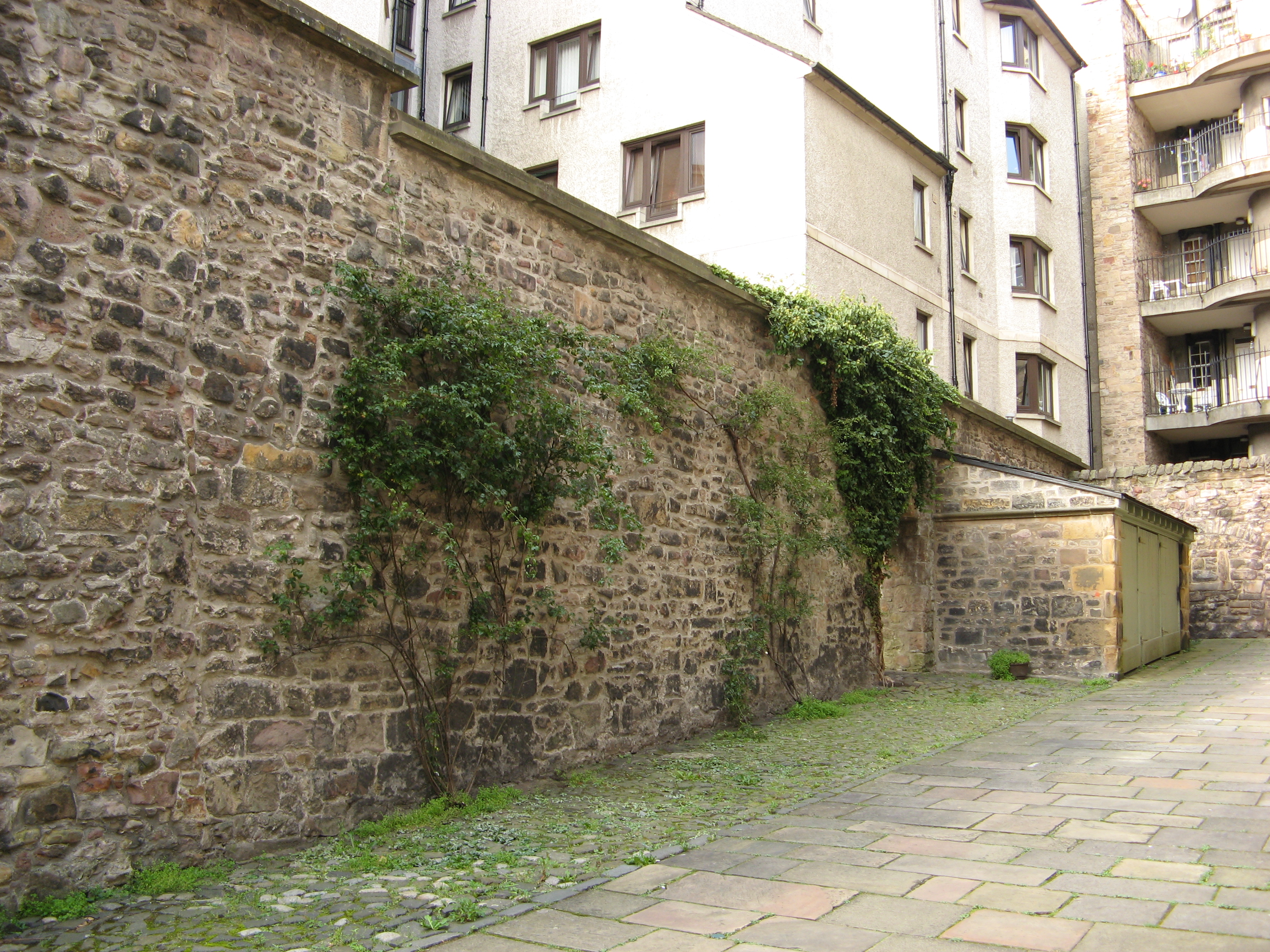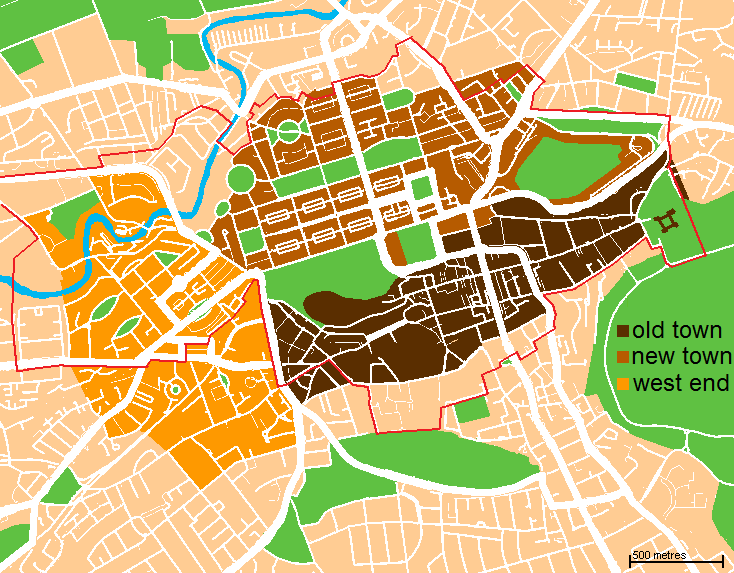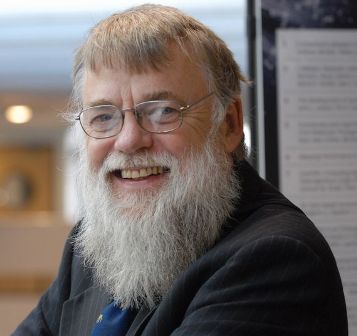|
Cowgate
The Cowgate (Scots language, Scots: The Cougait) is a street in Edinburgh, Scotland, located about southeast of Edinburgh Castle, within the city's World Heritage Site. The street is part of the lower level of Edinburgh's Old Town, Edinburgh, Old Town, which lies below the elevated streets of South Bridge, Edinburgh, South Bridge and George IV Bridge. It meets the Grassmarket at its west end and Holyrood, Edinburgh, Holyrood Road to the east. History Early history The Cowgate developed around 1330 and represented Edinburgh’s first municipal extension. The original settlement on the Cowgate was concentrated on the south side because of a Burn (landform), burn on the north, though that was filled in around 1490 and built upon. Archaeological excavations in the 2006 and 2007 found a boundary ditch, dating to the 14th century, near St Patrick's Church, Edinburgh, St Patrick's Church which might have been the full extent of the Cowgate at that time. The street's name is rec ... [...More Info...] [...Related Items...] OR: [Wikipedia] [Google] [Baidu] [Amazon] |
South Bridge, Edinburgh
South Bridge is a road bridge and street in the Old Town, Edinburgh, Old Town of Edinburgh, Scotland, between the Royal Mile#High Street, High Street, where it meets the North Bridge, Edinburgh, North Bridge, to Nicolson Street at the south. It forms a continuous roadway over the steep valley scoured parallel to the High Street when the crag and tail landscape of the city was formed. The bridge dips down from the High Street to the Cowgate (the roadway along the bottom of the valley), which runs under the largest arch of the bridge, before climbing back up to its terminus at Nicolson Street. The concept of the bridge was raised in 1784 by Sir James Hunter Blair, 1st Baronet, James Hunter Blair in his capacity as Lord Provost of Edinburgh, as a logical southward extension of the pre-existing North Bridge, which connected Edinburgh's Old Town to its New Town. The southward bridge, set on the same alignment, was to improve connection to the southward land, and spanned over the Cow ... [...More Info...] [...Related Items...] OR: [Wikipedia] [Google] [Baidu] [Amazon] |
St Patrick's Church, Edinburgh
St Patrick's Church is a Roman Catholic Parish church in the Cowgate part of Old Town, Edinburgh, Scotland. It was built from 1771 to 1774, and became a Catholic church in 1856. The facade of the church was designed by Reginald Fairlie in 1929. It is situated between South Gray's Close and St Mary's Street north of Cowgate and south of the Royal Mile. It is a category B listed building. History Before the Church The first records of the site are property deeds from 1503 to 1531 when it was a waste strip of land. When Archbishop James Beaton built his palace a short distance west of the church in 1509, he also purchased much of this waste land. Later Mary Queen of Scots’ Italian servant Francisco de Busso owned part of it. The north part of the church sites was owned, in the late 16th to early 17th centuries, by Dr John Naysmith, surgeon to James VI. The judge Sir James Elphinstone of Logie built ‘Elphinstone Court’ here in the 1670s. The Episcopal Congregation then ... [...More Info...] [...Related Items...] OR: [Wikipedia] [Google] [Baidu] [Amazon] |
Edinburgh Town Walls
There have been several town walls around Edinburgh, Scotland, since the 12th century. Some form of wall probably existed from the foundation of the royal burgh in around 1125, though the first building is recorded in the mid-15th century, when the King's Wall was constructed. In the 16th century the more extensive Flodden Wall was erected, following the Scots' defeat at the Battle of Flodden in 1513. This was extended by the Telfer Wall in the early 17th century. The walls had a number of gates, known as ports, the most important being the Netherbow Port, which stood halfway down what is now the Royal Mile. This gave access from the Canongate which was, at that time, a separate burgh. The walls never proved very successful as defensive structures, and were easily breached on more than one occasion. They served more as a means of controlling trade and taxing goods, and as a deterrent to smugglers. By the mid 18th century, the walls had outlived both their defensive and trade pu ... [...More Info...] [...Related Items...] OR: [Wikipedia] [Google] [Baidu] [Amazon] |
Old Town, Edinburgh
The Old Town () is the oldest part of Scotland's capital city of Edinburgh. The area has preserved much of its medieval street plan and many Scottish Reformation, Reformation-era buildings. Together with the 18th/19th-century New Town, Edinburgh, New Town, and West End, Edinburgh, West End, it forms part of a protected UNESCO World Heritage Site. Royal Mile The "Royal Mile" is a name coined in the early 20th century for the main street of the Old Town which runs on a downwards slope from Edinburgh Castle to Holyrood Palace and the ruined Holyrood Abbey. Narrow ''List of closes on the Royal Mile, closes'' (alleyways), often no more than a few feet wide, lead steeply downhill to both north and south of the main spine which runs west to east. Significant buildings in the Old Town include St. Giles' Cathedral, the General Assembly Hall of the Church of Scotland, the National Museum of Scotland, the Old College, University of Edinburgh, Old College of the University of Edinburgh, P ... [...More Info...] [...Related Items...] OR: [Wikipedia] [Google] [Baidu] [Amazon] |
Gilded Balloon
Gilded Balloon is a producer and promoter of live entertainment events, based in Edinburgh, Scotland, and best known as one of the Big Four venue operators at the Edinburgh Festival Fringe each August. The company has its origins in a venue known as The Gilded Balloon on Edinburgh's Cowgate, where artistic director Karen Koren first started promoting comedy events in 1986. When a Cowgate#2002 fire, fire in 2002 destroyed the original premises, Gilded Balloon shifted its Fringe operations to Teviot Row House in Bristo Square, which became the company's main venue. Gilded Balloon also operates outside the Fringe, running year round events at the Rose Theatre, Edinburgh. History Gilded Balloon founder, Karen Koren, started promoting comedy at McNally's, a restaurant and club based in a townhouse at 6 Palmerston Place, near Haymarket railway station, Haymarket Station, which opened in February 1985. The owner had intended to open a casino upstairs, but it was rejected for a licence ... [...More Info...] [...Related Items...] OR: [Wikipedia] [Google] [Baidu] [Amazon] |
Underbelly (venue)
Underbelly is a live events producer and venue operator, known as one of the "Big Four" venue operators at the Edinburgh Festival Fringe. From its roots as a Fringe venue, the company has expanded to include a festival on London's South Bank and seasonal events in Edinburgh and elsewhere. History Underbelly was founded in 2000 by directors Ed Bartlam and Charlie Wood to operate one venue at the Edinburgh Festival Fringe. In 2001, Underbelly Limited was formed to turn the Underbelly venue into a professional operation. Over the years, Underbelly's operations have expanded beyond the Cowgate, to include a hub space known as the Udderbelly pasture in George Square and a Circus Hub on The Meadows, as well as a hub in Bristo Square. Each Underbelly venue is recognisable by its purple, cow-themed branding, most notably a large, upside-down, inflatable purple cow which serves as one of the venues. In 2015, Underbelly hosted over 130 shows at the Fringe. For many years, Underbelly also ... [...More Info...] [...Related Items...] OR: [Wikipedia] [Google] [Baidu] [Amazon] |
Grassmarket
The Grassmarket is a historic market square, market place, street and event space in the Old Town, Edinburgh, Old Town of Edinburgh, Scotland. In relation to the rest of the city it lies in a hollow, well below surrounding ground levels. Location The Grassmarket is located directly below Edinburgh Castle and forms part of one of the main east-west vehicle arteries through the city centre. It adjoins the Cowgatehead/Cowgate and Candlemaker Row at the east end, the West Bow, Edinburgh, West Bow (the lower end of Victoria Street, Edinburgh, Victoria Street in the north-east corner, King's Stables Road, Edinburgh, King's Stables Road to the north-west, and the West Port, Edinburgh, West Port to the west. Leading off from the south-west corner is the Vennel, on the east side of which can still be seen some of the best surviving parts of the Flodden Wall, Flodden and Telfer Wall, Telfer town walls. The view to the north, dominated by the castle, has long been a favourite subject of p ... [...More Info...] [...Related Items...] OR: [Wikipedia] [Google] [Baidu] [Amazon] |
Thomas Hamilton (architect)
Thomas Hamilton (11 January 1784 – 24 February 1858) was a Scottish architect, based in Edinburgh where he designed many of that city's prominent buildings. Born in Glasgow, his works include: the Burns Monument in Alloway; the Old Royal High School, Royal High School on the south side of Calton Hill (long considered as a possible home for the Scottish Parliament); the Royal College of Physicians of Edinburgh; the George IV Bridge, which spans the Cowgate; the Dean Orphan Hospital, now the Dean Gallery; the New North Road Free Church, now the Bedlam Theatre; Cumstoun, a private house in Dumfries and Galloway; and the Scottish Political Martyrs' Monument in Old Calton Cemetery, Edinburgh. He was one of the leading Greek Revivalists in Scotland, "more imaginative than his peers and more refined in his detailing". He was a favourite of the church for his Gothic designs, being commissioned to design many Free Church of Scotland (1843–1900), Free Churches after the Disruption o ... [...More Info...] [...Related Items...] OR: [Wikipedia] [Google] [Baidu] [Amazon] |
George IV Bridge
George IV Bridge is an Viaduct, elevated street in Edinburgh, Scotland, and is home to a number of the city's important public buildings. History A bridge connecting the High Street to the south was first suggested in 1817, but was originally planned further west and was non-linear and complicated. Plans developed through the early 1820s, concluding in 1825 that a linear form aligned with Bank Street (which connects to The Mound, Edinburgh, The Mound and Princes Street) was more logical, even though this required greater destruction of existing buildings. This would be a bridge over the Cowgate and Merchant Street. The foundation stone was laid on 15 August 1827. Measuring in length, the bridge was constructed between 1827 and 1836 as a result of the Edinburgh Improvement Act 1827 (7 & 8 Geo. 4. c. lxxvi). Named after King George IV, it was designed by architect Thomas Hamilton (architect), Thomas Hamilton (1784–1858) to connect the South Side district of Edinburgh to th ... [...More Info...] [...Related Items...] OR: [Wikipedia] [Google] [Baidu] [Amazon] |
Informatics Forum
The Informatics Forum is a major building on the Central Area campus of the University of Edinburgh. Completed in 2008, it houses the research institutes of the university's School of Informatics. Design The Forum is designed by Bennetts Associates with Reiach and Hall, architects, and Buro Happold, engineers. The architects' brief was to provide a "forum for interaction" that will foster synergies among the 500 researchers in Informatics: Artificial Intelligence, Cognitive Science, Computer Science, and Systems Biology, who have been brought together, under one roof, by this development. The building was the first in Scotland to achieve a BREEAM rating of "excellent", and was constructed by Balfour Beatty. History One of the major recommendations of the 1997 international review that led to the formation of Informatics as an academic grouping at Edinburgh, was that the university should provide a building for the collocation of Informatics. An options appraisal recommen ... [...More Info...] [...Related Items...] OR: [Wikipedia] [Google] [Baidu] [Amazon] |
University Of Edinburgh School Of Informatics
The School of Informatics is an academic unit of the University of Edinburgh, in Scotland, responsible for research, teaching, outreach and commercialisation in informatics. It was created in 1998 from the former department of artificial intelligence, the Centre for Cognitive Science and the department of computer science, along with the Artificial Intelligence Applications Institute (AIAI) and the Human Communication Research Centre. Research in the School of Informatics draws on multiple disciplines. The school is particularly known for research in the areas of artificial intelligence, computational linguistics, systems biology, mathematical logic and theoretical computer science; but also contributes to many other areas of informatics. The School of Informatics is ranked 20th in the world by the QS World University Rankings 2023. As of 2022, the school is ranked 1st in the UK according to ''CSRankings'', 1st in the UK in the latest 2021 Research Excellence Framework (REF ... [...More Info...] [...Related Items...] OR: [Wikipedia] [Google] [Baidu] [Amazon] |
Margaret Beaton
Margaret Beaton, Lady Reres (floruit 1560–1580) was a Scottish courtier and companion of Mary of Guise and Mary, Queen of Scots. She was blamed by the enemies of Mary, Queen of Scots, for her involvement in alleged immorality at court. Career and rumour Margaret Beaton was a daughter of John Beaton of Creich, Keeper of Falkland Palace and Jane Hay, a daughter of the Provost of Dundee. Mary Beaton, one of Mary, Queen of Scots four companions was her niece, the daughter of her brother Robert Beaton of Creich. She married Arthur Forbes of Reres or Rires Castle in Kilconquhar, Fife, and was then called "Lady Reres". The place-name was sometimes written "Reresse". On 22 December 1558 Mary of Guise paid her £300. In September 1566 she was part of the household of James VI of Scotland at Stirling Castle, provided with a bed with curtains made from blue wool cloth called "ostage". Mary sent her two coffers for the prince's chamber. In December 1566 Mary bought her a gown of black vel ... [...More Info...] [...Related Items...] OR: [Wikipedia] [Google] [Baidu] [Amazon] |








